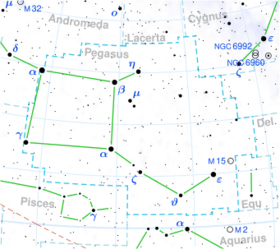Astronomy:Chi Pegasi
| Observation data Equinox J2000.0]] (ICRS) | |
|---|---|
| Constellation | Pegasus |
| Right ascension | 00h 14m 36.16451s[1] |
| Declination | 20° 12′ 24.1205″[1] |
| Apparent magnitude (V) | 4.80[2] |
| Characteristics | |
| Evolutionary stage | asymptotic giant branch[3] |
| Spectral type | M2+III[4] |
| U−B color index | +1.91[2] |
| B−V color index | +1.57[2] |
| Variable type | suspected[5] |
| Astrometry | |
| Radial velocity (Rv) | −46.26±0.57[6] km/s |
| Proper motion (μ) | RA: +90.76[1] mas/yr Dec.: +1.24[1] mas/yr |
| Parallax (π) | 8.86 ± 0.22[1] mas |
| Distance | 368 ± 9 ly (113 ± 3 pc) |
| Absolute magnitude (MV) | −0.47[7] |
| Details[8] | |
| Mass | 1.06±0.11 M☉ |
| Radius | 52.88+1.31 −1.37 R☉ |
| Luminosity | 435±23[9] L☉ |
| Surface gravity (log g) | 0.80 cgs |
| Temperature | 3,842±49 K |
| Metallicity [Fe/H] | 0.00 dex |
| Rotational velocity (v sin i) | 6.0[6] km/s |
| Age | 7.70±2.01 Gyr |
| Other designations | |
| Database references | |
| SIMBAD | data |
Chi Pegasi, Latinised from χ Pegasi, is a single[11] star in the northern constellation of Pegasus, along the eastern constellation border with Pisces. It has a reddish hue and is faintly visible to the naked eye with an apparent visual magnitude of 4.80.[2] The distance to this star is approximately 368 light-years based on parallax,[1] but it is drifting closer with a radial velocity of −46 km/s.[6]
This is an aging red giant star on the asymptotic giant branch[3] with a stellar classification of M2+III.[4] It is about 8 billion years old with a mass 6% greater than the Sun's. With the supply of hydrogen at its core exhausted, the star has cooled and expanded to 53 times the girth of the Sun. It is radiating around 435 times the luminosity of the Sun from its swollen photosphere at an effective temperature of 3,842 K.[8]
Chi Pegasi is a suspected small-amplitude variable.[5] Koen and Eyer examined the Hipparcos data for Chi Pegasi, and found that its brightness varied by 0.0094 magnitudes, with a period of 5.9641 days.[13]
References
- ↑ 1.0 1.1 1.2 1.3 1.4 1.5 Van Leeuwen, F. (2007). "Validation of the new Hipparcos reduction". Astronomy and Astrophysics 474 (2): 653–664. doi:10.1051/0004-6361:20078357. Bibcode: 2007A&A...474..653V. Vizier catalog entry
- ↑ 2.0 2.1 2.2 2.3 Ducati, J. R. (2002). "VizieR Online Data Catalog: Catalogue of Stellar Photometry in Johnson's 11-color system". CDS/ADC Collection of Electronic Catalogues 2237. Bibcode: 2002yCat.2237....0D.
- ↑ 3.0 3.1 Eggen, Olin J. (July 1992). "Asymptotic giant branch stars near the sun". Astronomical Journal 104 (1): 275–313. doi:10.1086/116239. Bibcode: 1992AJ....104..275E.
- ↑ 4.0 4.1 Keenan, Philip C.; McNeil, Raymond C. (1989). "The Perkins catalog of revised MK types for the cooler stars". Astrophysical Journal Supplement Series 71: 245. doi:10.1086/191373. Bibcode: 1989ApJS...71..245K.
- ↑ 5.0 5.1 Percy, John R.; Wong, Nancy; Bohme, Dietmar; Curott, David R.; Dempsey, Frank; Fortier, George L.; Ganis, Matt; Parello, Stephanie et al. (June 1994). "Photometric Surveys of Suspected Small-Amplitude Red Variables. III. an AAVSO Photoelectric Photometry Survey". Publications of the Astronomical Society of the Pacific 106: 611. doi:10.1086/133420. Bibcode: 1994PASP..106..611P.
- ↑ 6.0 6.1 6.2 Massarotti, Alessandro et al. (January 2008). "Rotational and Radial Velocities for a Sample of 761 HIPPARCOS Giants and the Role of Binarity". The Astronomical Journal 135 (1): 209–231. doi:10.1088/0004-6256/135/1/209. Bibcode: 2008AJ....135..209M.
- ↑ Anderson, E.; Francis, Ch. (2012). "XHIP: An extended hipparcos compilation". Astronomy Letters 38 (5): 331. doi:10.1134/S1063773712050015. Bibcode: 2012AstL...38..331A. Vizier catalog entry
- ↑ 8.0 8.1 Baines, Ellyn K. et al. (2018). "Fundamental Parameters of 87 Stars from the Navy Precision Optical Interferometer". The Astronomical Journal 155 (1): 30. doi:10.3847/1538-3881/aa9d8b. Bibcode: 2018AJ....155...30B.
- ↑ Brown, A. G. A. (August 2018). "Gaia Data Release 2: Summary of the contents and survey properties". Astronomy & Astrophysics 616: A1. doi:10.1051/0004-6361/201833051. Bibcode: 2018A&A...616A...1G. Gaia DR2 record for this source at VizieR.
- ↑ "chi Peg". SIMBAD. Centre de données astronomiques de Strasbourg. http://simbad.u-strasbg.fr/simbad/sim-basic?Ident=chi+Peg.
- ↑ Eggleton, P. P.; Tokovinin, A. A. (September 2008). "A catalogue of multiplicity among bright stellar systems". Monthly Notices of the Royal Astronomical Society 389 (2): 869–879. doi:10.1111/j.1365-2966.2008.13596.x. Bibcode: 2008MNRAS.389..869E.
- ↑ "Light Curve". ESA. https://www.cosmos.esa.int/web/hipparcos/java-tools/light-curve.
- ↑ Koen, Chris; Eyer, Laurent (March 2002). "New periodic variables from the Hipparcos epoch photometry". Monthly Notices of the Royal Astronomical Society 331 (1): 45–59. doi:10.1046/j.1365-8711.2002.05150.x. Bibcode: 2002MNRAS.331...45K.
External links
- Kaler, James B. (December 19, 2014). "Chi and Psi Pegasi". STARS. http://stars.astro.illinois.edu/sow/chipeg.html. Retrieved 2019-10-24.
 |



